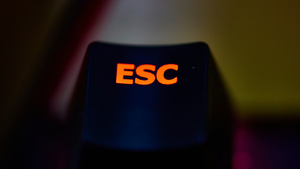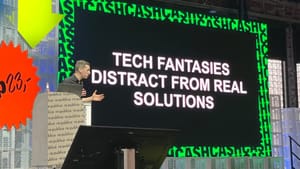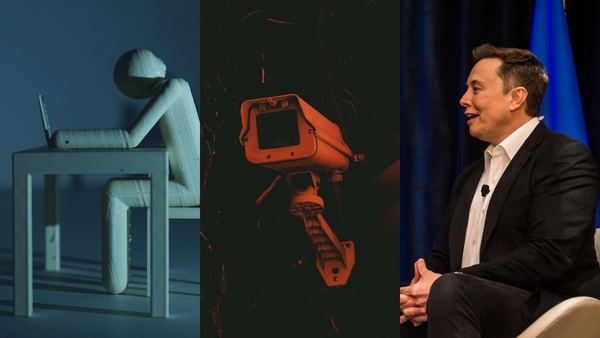
OpenAI has reportedly been in talks about a funding round valuing the company at over $100 billion since December, and now it’s nearing completion. But the news about the round and who’s planning to participate in it tells us a lot about the state the tech industry and the generative AI bubble.
First of all, The Information reported in July that OpenAI is losing money hand over fist. Other generative AI companies are in the same boat, but since it’s the biggest, it’s losing the most. It’s expected to lose $5 billion this year alone, which is precisely why it desperately needs more money not just to keep the lights on, but to keep the illusion fueling the AI hype alive. The upcoming Oprah Winfrey AI special is part of that effort too — but more on that another time.
Since the short-lived ouster of Sam Altman in November of last year, talk of his desire to further alter OpenAI’s corporate structure have persisted. OpenAI is technically a non-profit company that added a for-profit subsidiary in 2019 so it would make its big deal with Microsoft. But the idealism that justified starting it as a non-profit is gone. Altman, OpenAI’s investors, and I’m sure even many of its employees want the benefits of for-profit status. The Financial Times is reporting that OpenAI is planning to restructure itself to coincide with this funding round, which could include removing the cap of profits for investors at the for-profit subsidiary and further “simplifying” its structure.
Some of the potential investors in that round are also quite illustrative. Media reports suggest Apple may be looking to invest in OpenAI, following the announcement earlier this summer that its generative AI tools will be accessible directly through the company’s operating systems in the near future. It’s a bit surprising to see that relationship strengthening given the ongoing controversy around OpenAI, but what it shows most clearly is how little vision CEO Tim Cook has for Apple and his need to chase short-term hype because of the lack of long-term vision at the company under his leadership. For him, it only matters if the line is going up, even if that means stealing artists’ work to power Apple’s AI models, making ads that piss off the artist community, or getting in bed with the company that’s driving a major corporate assault on artists’ livelihoods.
But another of the investors is also a little surprising, if not just a funny commentary on our current moment. Nvidia is also reportedly planning to invest in OpenAI, a company that is now one of the most valuable in the world mainly because of the hype — and enthusiastic buying of Nvidia’s graphics processing units — that the latter kicked off. I guess it doesn’t hurt for Nividia to take some of the profits its made from its massive overvaluation thanks to the generative AI bubble and put them into OpenAI, but it does start to feel a bit like the snake eating its tail with bubble money trying to keep inflating a bubble that very clearly feels to be beginning to deflate.
Another great roundup this week with pieces on the copyright fight over generative AI, how the Philippines is thinking about what AI might do to its call center industry, and how Tesla has screwed over other automakers. I’m also planning to write about the Twitter/X ban in Brazil and the arrest of Telegram CEO Pavel Durov this coming week, so stay tuned for that.
Over on Tech Won’t Save Us, I spoke to Gabi Schubiner and Mohammad Khatami of No Tech for Apartheid about how major US tech companies like Amazon, Microsoft, and Google are enabling Israel’s genocide against Palestinians and how tech workers are trying to push back against their employers.
Have a great week!
— Paris
Recommended reads
- Over at The Verge, Elizabeth Lopatto has a great piece digging into why OpenAI is making deals with publishers and what it would mean if it’s found to be violating their copyrights as the lawsuit brought by the New York Times works its way through the courts.
- What will new AI tools mean for call centers? Saritha Rai has a deep dive on the reaction in the Philippines, which has the second largest call center industry in the world. The story discusses the fears and the corporate experimentation under way, but also notes there are reasons to be cautious about the scale of the impact the new tech will ultimately have. [archive]
- Last year, a slew of automakers in North America announced they’d be switching to Tesla’s charging standard and that the company would open up its Supercharger network to other brands. But, as Jack Ewing writes in the New York Times, that “made them vulnerable to the whims of Mr. Musk.” A year later, the network still isn’t open and charging adapters have been delayed. [archive]
Labor updates
- Uber drivers in Kenya have developed their own rate chart, going against the company’s rules to charge riders higher (and fairer) prices.
- Apple is cutting 100 workers from its News and Books teams.
- A new California bill championed by SAG-AFTRA will require explicit consent before the use of a performer’s “digital replica.”
- New rules in Australia could mean better minimum standards for gig workers, but won’t go as far as making them employees.
In other news
Twitter/X has been banned in Brazil after the company refused to comply with orders from the Supreme Court. The court also froze Starlink’s local bank accounts to pay Twitter/X’s fines. [archive]
Israel is buying Google ads in its campaign to try to discredit the UN’s top aid agency operating in Gaza.
Telegram CEO Pavel Durov has been indicted on six charges in France, including for managing a platform to enable an illegal transaction in an organized group and refusing to cooperate with law enforcement. He was released on a €5 million bail and has to check in with police twice a week.
Thieves have figured out you can peel down the “shatter-proof” windows of the Cybertruck and get inside without ever setting off the alarm.
Tesla has been shipping a ton of EVs from its Shanghai factory to Canada since last year. They’ll now be hit with a 100% tariff, along with other EVs made in China.
Tesla reportedly asked Canada to apply a lower tariff on its vehicles.
Harmful AI undressing apps and deepfake websites are still using sign-on systems provided by Google, Apple, Discord, Twitter, Patreon, and Line. [archive]
Jenny Ortega says she quit Twitter because she was seeing AI-generated explicit photos of herself as a teenager.
New data centers in Northern Virginia will have to wait up to seven years for electricity connections. [archive]
Meanwhile, a Google data center planned for southern Dublin has been rejected over a lack of national grid capacity and insufficient renewable energy.
Elon Musk’s xAI is using natural gas burning turbines to power its AI data center without the proper permits. It’s making the air quality and smog in Memphis, Tennessee even worse.
The United States is threatening to escalate a dispute with Canada over its new digital services tax, though the tax only exists because the US has been stalling a multinational tax treaty that’s supposed to establish a minimum corporate tax rate.
Amazon is looking to buy land in New Zealand for its internet-from-space division, Project Kuiper. [archive]
New research shows large language models are biased against African American English.
Yelp is the latest company to sue Google for anticompetitive behavior.
Popular pirating websites are going offline as Hollywood studios renew their crack down on piracy.
In another sign the metaverse is dead, Meta closed an augmented reality studio as it refocuses on AI.
North Korean hackers found an exploit in Chrome to steal some more crypto.
Uber was fined €290 million for sending drivers’ data outside the European Union.
One more thing
After all the videos circulating of Cybertrucks breaking down and malfunctioning, someone’s put together a funny video in the style of a nature documentary narrated by David Attenborough talking about its dependency on the flatbed truck. It’s pretty funny! Unfortunately, I’m not sure who originally made it.
(You can also watch it on Threads.)










Member discussion